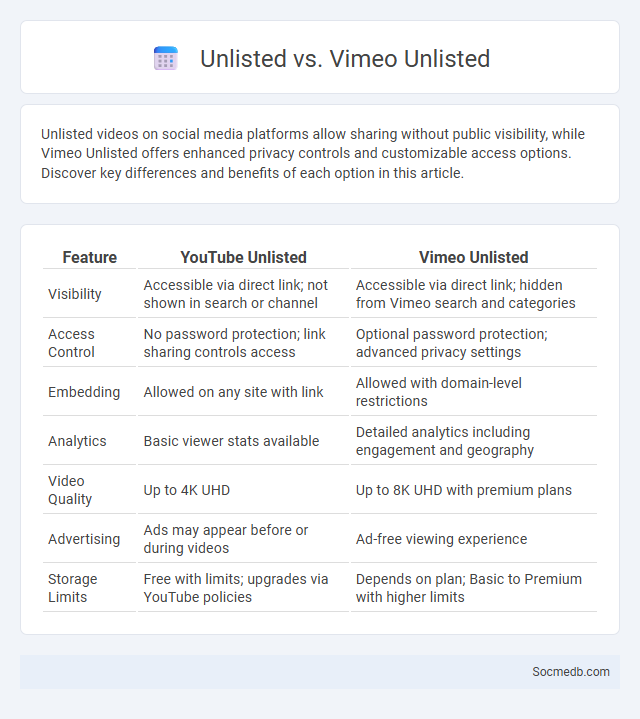
Photo illustration: Unlisted vs Vimeo Unlisted
Unlisted videos on social media platforms allow sharing without public visibility, while Vimeo Unlisted offers enhanced privacy controls and customizable access options. Discover key differences and benefits of each option in this article.
Table of Comparison
| Feature | YouTube Unlisted | Vimeo Unlisted |
|---|---|---|
| Visibility | Accessible via direct link; not shown in search or channel | Accessible via direct link; hidden from Vimeo search and categories |
| Access Control | No password protection; link sharing controls access | Optional password protection; advanced privacy settings |
| Embedding | Allowed on any site with link | Allowed with domain-level restrictions |
| Analytics | Basic viewer stats available | Detailed analytics including engagement and geography |
| Video Quality | Up to 4K UHD | Up to 8K UHD with premium plans |
| Advertising | Ads may appear before or during videos | Ad-free viewing experience |
| Storage Limits | Free with limits; upgrades via YouTube policies | Depends on plan; Basic to Premium with higher limits |
Understanding ‘Unlisted’ Videos: Definition and Key Features
Unlisted videos on social media platforms like YouTube are videos that do not appear in public search results, recommendations, or the uploader's channel list, ensuring controlled visibility. Only users with the direct link can view and share these videos, providing a semi-private option ideal for selective sharing without complete public exposure. Understanding these key features helps you manage your content's accessibility while maintaining privacy and audience control.
What is Vimeo Unlisted? How Does It Work?
Vimeo Unlisted is a privacy setting that allows you to share videos only with people who have the direct link, preventing them from appearing in public searches or on your Vimeo profile. This feature works by generating a unique URL accessible only to those you choose to share it with, ensuring controlled distribution of your content. Your videos remain hidden from broader audiences, providing a secure way to showcase work privately to clients, collaborators, or select viewers.
YouTube Unlisted vs Vimeo Unlisted: Comparing the Basics
YouTube Unlisted videos allow you to share content via a direct link without making it publicly searchable, ideal for private sharing or limited audience engagement. Vimeo Unlisted, often referred to as "Private Link," offers enhanced privacy controls such as password protection and domain-level embedding restrictions, catering to professional or business use. Your choice depends on whether you prioritize YouTube's extensive reach and ease of access or Vimeo's advanced privacy features and customization options.
Privacy and Accessibility: Who Can Watch Unlisted Videos?
Unlisted videos on social media platforms like YouTube are accessible only to users with the direct link, ensuring they do not appear in public searches or on your channel. This privacy setting allows you to share content selectively without making it fully public, enhancing control over your audience. You can confidently distribute unlisted videos to specific viewers while maintaining a level of privacy and limiting accessibility.
How to Create an Unlisted Video on Major Platforms
Creating an unlisted video on major platforms like YouTube involves setting your video's privacy to "Unlisted," which ensures only people with the direct link can view it, keeping it hidden from public searches and your channel page. On Facebook, you can upload your video as "Private" and share it directly with select friends or groups to maintain controlled access. Instagram allows you to share videos via direct messages or close friends' stories, while TikTok doesn't offer unlisted options but lets you set videos to "Friends" or private, managing your audience visibility effectively for Your content.
Sharing and Embedding: Differences in Link Control
Sharing on social media involves posting links to external content where the platform controls the display and user interaction, often limiting customization options. Embedding allows users to insert interactive content directly into posts or webpages, granting greater control over appearance and functionality while maintaining the original source's dynamic features. Link control in sharing is more constrained, whereas embedding provides enhanced customization and engagement opportunities.
Use Cases: When to Choose Unlisted Over Public or Private
Unlisted social media posts offer a strategic advantage for sharing content with a specific audience without making it publicly searchable, ideal for exclusive promotions, event invitations, or beta testing feedback. Unlike public posts that maximize reach or private posts that restrict access entirely, unlisted content balances visibility and confidentiality, ensuring only users with the direct link can view it. This selective access is especially valuable for businesses aiming to control audience scope while maintaining the ability to gather targeted insights or engagement.
Security Risks of Unlisted and Vimeo Unlisted Videos
Unlisted videos on social media platforms like Vimeo pose significant security risks due to their reliance on obscurity rather than robust access controls, making them vulnerable to unauthorized viewing through shared links or link guessing. Unlike truly private videos, unlisted content can be indexed by search engines or inadvertently exposed, increasing the chance of data leaks or misuse. Implementing strict access restrictions and regularly reviewing sharing settings are essential to mitigate these vulnerabilities and protect sensitive media assets.
Analytics and Performance Tracking for Unlisted Content
Social media analytics for unlisted content enable You to monitor engagement metrics such as views, shares, and interaction rates without public exposure. Performance tracking tools provide detailed insights into audience behavior, helping optimize content effectiveness and refine targeting strategies. These analytics empower marketers to make data-driven decisions while maintaining content privacy and exclusivity.
Best Practices for Managing and Sharing Unlisted Videos
Unlisted videos on platforms like YouTube and Vimeo offer a secure way to share content without public exposure, enabling controlled access via direct links. Best practices include setting clear permissions, regularly updating access lists, and embedding videos only on trusted sites to prevent unauthorized distribution. Utilizing analytics tools to monitor viewer engagement and maintaining consistent communication with the audience enhances privacy while maximizing content reach.
 socmedb.com
socmedb.com